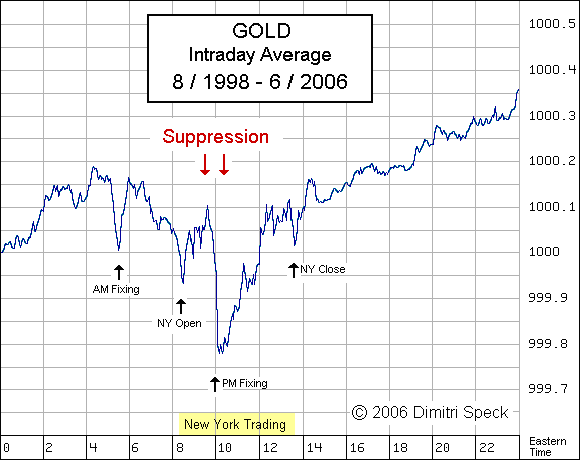Gold Market Interventions
Gold Market Interventions
Dimitri Speck
Since August 5, 1993, there has been a systematic attempt to administer downward impulse to the gold price through loans and sales of the metal. The intention of the involved Central Banks is to maintain low inflation rate expectations. An additional goal is to strengthen trust in the dollar, the bond market and the financial system in general. Intervention is only made possible by bank vault supplies of the metal which are several times yearly demand. Similar to common practices in the currency market, these interventions are not made public.
There are a number of signs indicating these systematic interventions. Especially succinct was Federal Reserve Governor Angell's statement made when the interventions began: "We can hold the price of gold very easily". Fed Chief Alan Greenspan provided another example: "central banks stand ready to lease gold in increasing quantities should the price rise". Indeed Greenspan's statement was made in a different context; however the quote shows that willingness to apply market pressure was present. Additionally he referred to gold leasing as a means to suppress prices. This leads to gold supplies reaching the physical market - evidently independent of gold mine hedging requirements. The actual intervention is then done by the banks, which loan the gold (a division of labor similar to that of the suspected support buying following the 1987 stock market crash). Incidentally, the majority of central banks fail to publicize the extent of the gold loan activities.
How do we know the date when the systematic interventions began? By observing their execution times. These actions are not divided evenly throughout the day, but instead tend to focus on important time points such as the PM-Fixing and the New York closing price. Additionally, COMEX trading hours are preferred. This creates an intra-day pattern that can be statistically identified and allows us to pinpoint the starting date of the interventions on August 5, 1993 (*).
This intra-day anomaly existed for a very long time, but has weakened the last few years in the course of the continued upward trend in prices. The attached chart shows the average intra-day trend of all days for which there are high numbers of price fixings. The right axis shows the price, the bottom scale the time of day. The average is calculated by taking the minute by minute prices throughout the day from about 2000 days and consolidating them as a single day. Thus this so-called intra-day seasonal chart shows at a glance how intra-day prices behaved over the last eight years.

Chart: Average Intra-day Price Trend of Gold 08/1998-06/2006
Clearly visible is the price decrease at the time of the London afternoon fixing. The minor lows near the morning fixing as well as the open and close in New York are all worth noting. Also conspicuous is that during American market hours the price generally trends sideways, in contrast to the rest of the time when it is moving upwards.
The upwards trend that Gold has been in for the last several years, does not mean that interventions no longer take place. They are however not as frequent (and are thus more difficult to prove statistically). Moreover they retard the rising trend or lead to temporary pullbacks, but in all they no longer prevent the price from increasing. However they remain one of the most important influential factors in the Gold market. This is also the case because of there own history: for instance, the actions led to mine closures following years of artificially suppressed gold prices. Not only that, it also means the base price level of gold is low making its potential high.
Dimitri Speck
October 27, 2006
www.SeasonalCharts.com
(*) More, and sources:
www.gata.org
www.gold-eagle.com/research/bolserndx.html
www.gold-eagle.com/research/clawarndx.html
www.gold-eagle.com/research/speckndx.html
Labels: gold















![[Most Recent Quotes from www.kitco.com] [Most Recent Quotes from www.kitco.com]](http://www.kitco.com/images/live/t24_au_en_usoz_6.gif)
![[Most Recent Quotes from www.kitco.com] [Most Recent Quotes from www.kitco.com]](http://www.kitco.com/images/live/au_go_0030_ny.gif)
![[Most Recent Quotes from www.kitco.com] [Most Recent Quotes from www.kitco.com]](http://www.kitco.com/images/live/au_go_0365_ny.gif)
![[Most Recent Quotes from www.kitco.com] [Most Recent Quotes from www.kitco.com]](http://kitconet.com/charts/metals/silver/t24_ag_en_usoz_4.gif)

















0 ΣΧΟΛΙΑ (COMMENTS):
Post a Comment
<< Home